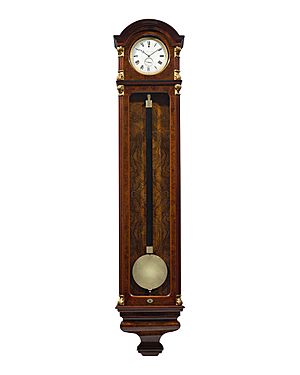Pendulum clock facts for kids
A pendulum clock is a special type of clock that uses a swinging weight, called a pendulum, to keep track of time. The great thing about a pendulum is that it swings back and forth in a very steady and precise way. This makes it perfect for telling time accurately.
From when it was invented in 1656 by Christiaan Huygens until the 1930s, the pendulum clock was the most accurate way to tell time in the world. Because they were so precise, these clocks were used everywhere – in homes, factories, offices, and train stations. They helped people schedule their daily lives, work shifts, and public transportation. Their accuracy even helped the Industrial Revolution move faster! Later, in the 1930s and 1940s, cheaper electric clocks took their place. Today, pendulum clocks are mostly valued for their beautiful designs and as antique items.
Pendulum clocks need to stay still to work correctly. If they move or shake, the pendulum's swing will be affected, making the clock inaccurate. That's why other types of mechanisms are used in clocks you can carry around.
Cool Styles of Pendulum Clocks
Pendulum clocks were more than just tools for telling time; they were also status symbols that showed how wealthy and cultured their owners were. Over time, many different traditional styles developed, often specific to certain countries or periods. The designs of the clock cases often matched the popular furniture styles of the time. Experts can often guess when an antique clock was made just by looking closely at small details in its case and face.
Here are some of the different styles of pendulum clocks you might find:
- Act of Parliament clock
- Anniversary clock (uses a special torsion pendulum)
- Banjo clock
- Bracket clock
- Cartel clock
- Comtoise or Morbier clock
- Crystal regulator
- Cuckoo clock
- Grandfather clock
- Lantern clock
- Mantel clock
- Master clock
- Ogee clock
- Pillar clock
- Schoolhouse regulator
- Turret clock
- Vienna regulator
- Zaandam clock
Images for kids
-
A tall Grandfather clock.
See also
 In Spanish: Reloj de péndulo para niños
In Spanish: Reloj de péndulo para niños






